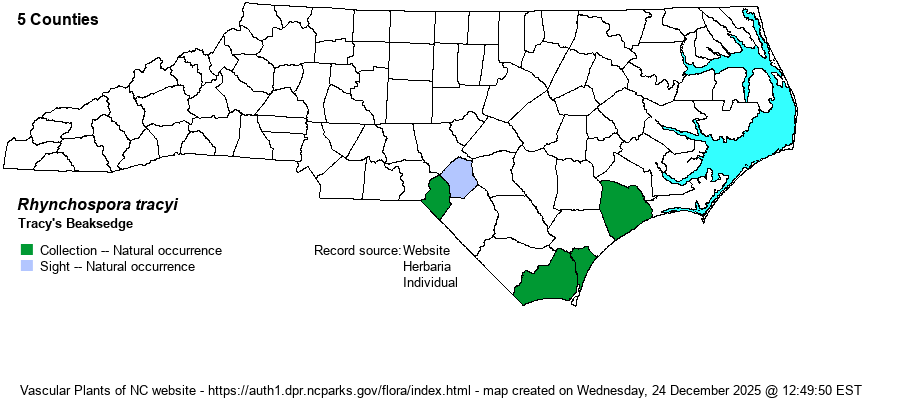| Author | Britton | |
| Distribution | The southern outer Coastal Plain; disjunct to the inner Coastal Plain of Scotland County (Tunstall's Bay) and Hoke County (Antioch Bay).
Southern NC to southern FL and eastern TX; Bahamas, West Indies, Belize. | |
| Abundance | Rare throughout, with small-acreage habitats (on the landscape). The NCNHP database lists 28 records, most of them extant, though a number of these are on Camp Lejeune. This is a State Threatened species. | |
| Habitat | Depression ponds, interdune sinkhole ponds, clay-based Carolina bays (Scotland and Hoke counties). Usually grows with Pond Cypress (Taxodium ascendens). |
| Phenology | Flowering and fruiting late June-September. | |
| Identification | These plants are very tall (3-5 feet high), slender, and form colonies via runners. It is unique in its 1-2(-4) spherical heads at the stem tips, and seeds with an abrupt slender beak 4-5 mm long. | |
| Taxonomic Comments | None
Members of the genus Rhynchospora -- mainly called beaksedges but also called beakrushes -- are mostly Coastal Plain in distribution and are important members of our longleaf pine savannas, flatwoods, streamheads, depression ponds, Carolina bays, and beaver ponds. They vary from small and wiry to large and coarse. Keys concentrate on features of the achenes (seeds) and the shape and arrangement of the flower clusters (spikelets). The seeds may or not have bristles at their base; bristle number, length, and toothing are critical characters. Size and shape of the seed beaks is also critical. The drawings in Godfrey & Wooten (1979) are extremely helpful. The genus now includes Dichromena, the white-topped sedges. | |
| Other Common Name(s) | None | |
| State Rank | S2 | |
| Global Rank | G4 | |
| State Status | T | |
| US Status | | |
| USACE-agcp | OBL link |
| USACE-emp | | |

